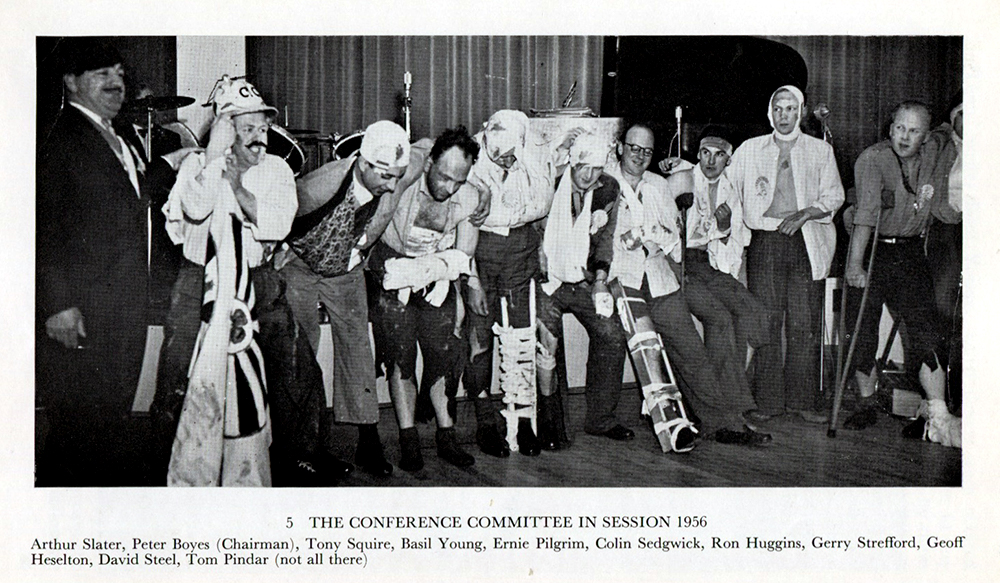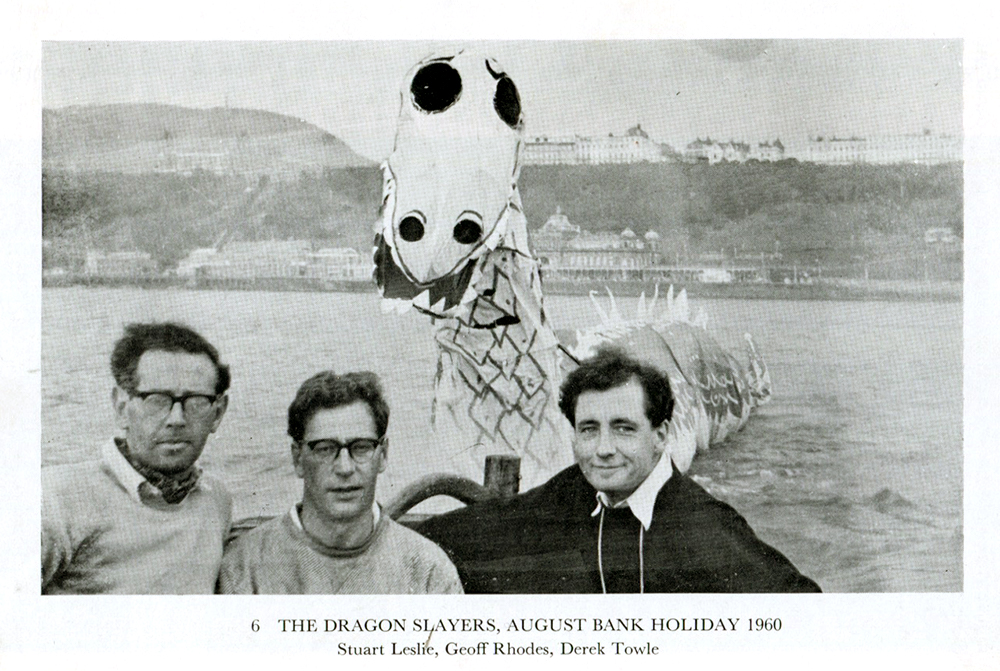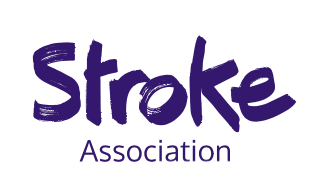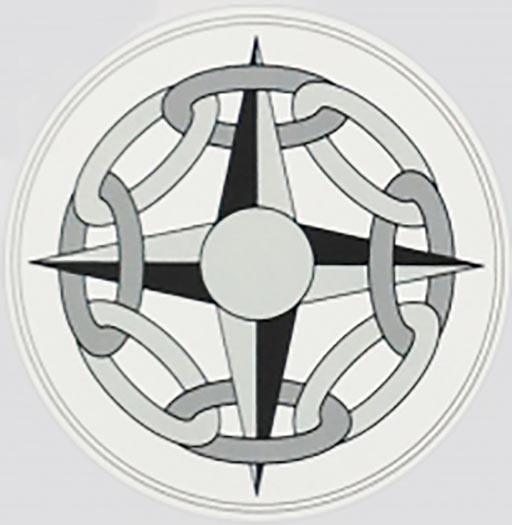The Third Scarborough Conference, 1962
AT THE BEGINNING of the present decade the size of the annual Round Table Conferences had grown to such proportions that there were not many towns in the country large enough to house them. Doubts were even being expressed whether Scarborough was big enough. Similar doubts have been expressed from time to time by other organisations, not excepting the larger political parties, but ‘What I said at Scarborough’, has nevertheless become part of the oratorical stock-in-trade of Prime and other Ministers irrespective of their persuasions.
As, by this time, R.T. Conferences had reached the 3,000 mark, these doubts were perhaps reasonable. Nevertheless and in spite of them, Scarborough’s reputation for first-class hospitality and entertainment, and the Table’s notoriety for the originality of its welcome, brought Conference to the town for the third time.
Aberdeen was the venue of the 1960 Conference, and to Aberdeen went five members of the Scarborough Table and their wives with the object of inviting the 1961 Conference to Scarborough. The contingent comprised Neville and Kath Gray, Geoff and Sheila Heselton, Tom and Margery Pindar, Colin and Lillian Sedgwick and Basil and Mary Young, all of whom were to play a large part in the work ahead.
‘We stayed,’ wrote Basil Young, ‘in a small hotel outside which was a large church clock. Geoff and Sheila hardly slept a wink during the four nights because of the noise when it struck the hours, halves and quarters.’
When the invitation was made, Scarborough had a competitor in Blackpool, and to Blackpool Conference went in 1961. Scarborough’s invitation was accepted for 1962 [46] and the Table, therefore, had two years to prepare for what was to be by far its largest R.T. Conference.
The Scarborough Kipper Machine
To Blackpool, too, went a large Scarborough contingent to extend the customary formal invitation and indulge in the customary informal publicity activities associated with it. It so happened that, if the Table were to participate in the 1961 Scarborough Dutch Festival, a successor to the late lamented dragon would have to be found. Here was a chance to kill two birds with one stone.
The Scarborough Kipper Machine was born. A fearful, complicated and colourful contraption, it made its way by road to Blackpool to participate in the final conference cabaret. Perhaps with memories of Torquay in mind (or, on the other hand, perhaps not) it did not fling kippers. At one end it took into its bowels the National President and at the other extruded him in kippered form. Then it came home and won a prize in the Dutch Festival.
The machine’s progress as it was towed from Scarborough to Blackpool and back is no doubt still remembered along the route. By the time it got to Leeds, where Arthur Holmes and the late John Ellender made a stop in Roundhay Park on the way back, it was surrounded by a crowd of admiring children who found themselves the richer by several real kippers, and a Yorkshire Post photographer did justice to the scene. A pleasing sequel was the subsequent presentation of a basket of fruit to Brian Gooch’s mother-in-law for allowing the erection of the machine in her back garden.
The Conference
‘In October 1960 Neville Gray was appointed Conference Chairman,’ writes Geoff Heselton, ‘with Basil Young as Secretary and a supporting committee, many of whom had had experience of the 1956 Conference. Basil then moved to Thirsk, and some reorganisation took place. Eventually Geoff Heselton became Secretary, Arnold Wilson Treasurer, and Basil Young undertook the mammoth task of Registration from his office in Thirsk.
‘Meetings were held almost weekly and an enormous organisation was built up, using all the available Scarborough Tablers and many from Area 15. It was recognised that the [47] numbers would be greater than ever before, and the Spa was brought into service. The bandstand was covered over by marquees, and the decor and presentation of the buffet supper on the Friday night had to be seen to be believed. Art students from the College of Art were enlisted to assist, and the Grand Hall was transformed by massive mobiles suspended from the roof and by many other decorations throughout the building.
‘Nothing was left to chance, and the detailed programme and instructions with which the committee coped (in addition to their normal jobs) was quite staggering. Golf competitions, children’s tea parties and a concert by Sooty, the Annual Meeting at the Futurist Theatre and quick lunches arranged at a number of cafes along the Foreshore, the Arcadia Theatre for the Ladies’ Circle Annual Meeting and separate cafes for their lunch, meeting rooms for this National Committee or that National Committee, rooms at the Public Library for informal discussions, cabaret artistes for the Ball on the Spa and the second function at the Grand Hotel.
‘Outside caterers had to be brought in to provide the meal at the Rendezvous Club, Cayton Bay, and transport also had to be laid on. At the Fancy Dress Party at the Spa both the Grand Hall and the Ballroom and every other inch of available space were in use, and the Corporation catering facilities were stretched to their limit.
‘Finally, car parking arrangements had to be made, and one of the amusing sidelights was that after it was all over, the Conference Chairman and Secretary could be seen early in the morning wearily collecting up the red lamps. Everyone else had gone and left them to it.’
Thirsk and the Conference
Basil Young’s removal to Thirsk, which took place little more than a year before the date of the Conference, had one far-reaching effect. It brought the Thirsk Table right into the front line, and in fact the Registrations, all 3.500 of them (ten times the number of 25 years earlier) were dealt with there. Jim Lister at Thirsk became Deputy Registration Officer, and eventually the members of the Thirsk Table and their wives were all involved in checking, sorting and indexing the forms. [48]
‘Then,’ writes Basil Young, ‘when tickets were printed and received, Thirsk members spent many hours in my office making up the envelopes. The hours worked by them and their wives on registration easily exceeded four figures.
‘Later they helped to man the Registration Office at the Royal Hotel during the period of the Conference. An early arrival at the Royal was Bryan Coker from Grays, Essex, who later in the Conference was elected Vice-President of R.T.B.I. He helped to set up the Registration Office, and as a result of the friendship that resulted, he visited Thirsk Charter Anniversary in November 1963 when I was Table Chairman and he was National President.
In appreciation of the tremendous assistance given by Thirsk, the Scarborough Table, at a joint meeting held later at Pickering, presented the Thirsk Table with a meeting-place plaque lest, as is most unlikely, Thirsk should ever forget the consequences of Basil Young’s removal thither.
Cabaret
We have hitherto looked at the Table floor shows more or less through the eyes of the beholder. Through the eyes of Michael Plows we are privileged to go back stage and see what really happened at the end of the 1962 Conference:
‘The part of the Cabaret that really sticks out in my mind was not the main Cabaret but the single item at the end of the Fancy Dress Ball. It was a fine example of how to get away with something when you never actually do anything that you intended to do in the first place.
‘The idea was to shoot an aeroplane down with a boomerang. It would then crash and the retiring National President would emerge. The rehearsals which took place at Colin Sedgwick’s went reasonably well, and a few days before the Conference all was well. The props were a little more difficult. The construction of the plane, which was not easy, went well at Brian Heaps’s and gradually took shape after a lot of experiments. The main problem was the electrics. The Table expert, Dennis Hart, conceived a plan to link batteries in series under the wing to light up the plane for a matter of seconds. Amazingly it worked, but the weight of the batteries was too much for the wing, and in any case the light wasn’t bright enough. After several evenings following [49] up this system we decided to have a spotlight.
‘The plane, which was to run down a wire, missing by inches the giant-sized roundabout hanging from the ceiling, was tested and all was well. Sound effects were recorded.
‘The time came for the Cabaret. As it was rather late in the evening all taking part had imbibed pretty well. We also hadn’t allowed for the noise and chatter in the hall. We couldn’t hear the record.
‘The natives tottered on the stage after a third of the record had played. The kangaroo hopped on as his footsteps on the record hopped off. The witch-doctor jumped on and the white hunter showed he could throw a boomerang. The plane came down; the spotlight couldn’t keep up with it, and it crashed into the side of the stage not with the explosion that was supposed to take place but with a thud that put some lights out. The witch-doctor was thrown into a tub, but in his efforts to avoid the sharp spear he was holding didn’t protect his head and was knocked unconscious.
‘What happened then is a little vague, for when I came to I was alone on the stage. I tottered off feeling very much the worse for wear. Of the rest of the Cabaret I can remember very little. Surprisingly enough, everyone thought that the whole thing was marvellous and didn’t realise what had been happening.’
We need not, however, leave the scene at this point as Michael Plows left it. The story was continued and concluded by George Ramsay in News and Views the following month:
‘From behind the wreckage emerged Pied Piper – alias National President Colin Firth. At the same time from the far end of the hall entered the Brighton Old Crock, to pick up Colin as he stood thumbing a lift in the centre of the floor. Amid fearful backfiring, and with encouraging pushes, the convoy disappeared towards Brighton 1963; and so, to the strains of Auld Lang Syne, officially ended Scarborough 1962.’ [50]



